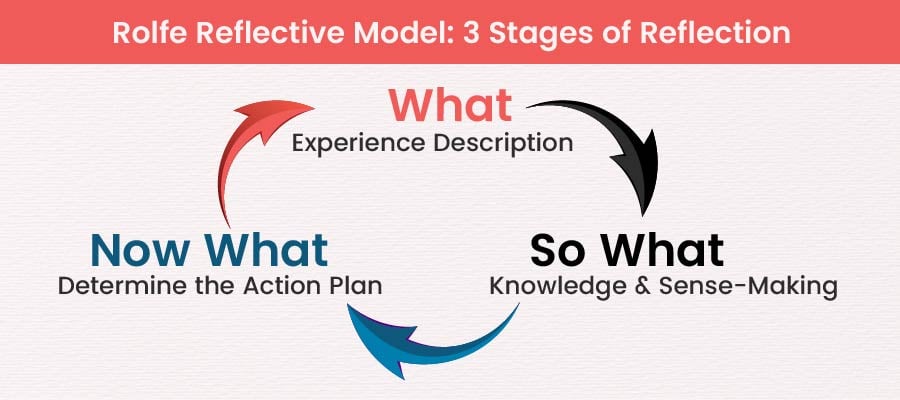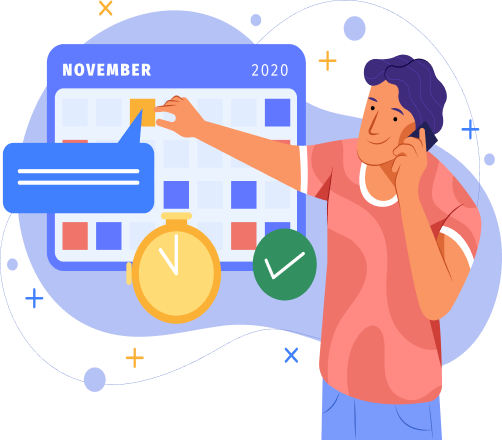Rolfe Reflective Model: A Practical Guide for Practitioners
Want to make self-growth? Find the meaning, stages, & examples of the Rolfe reflective model.
Want to make self-growth? Find the meaning, stages, & examples of the Rolfe reflective model.
Table of Content
What Are the Steps of the Rolfe Model of Reflection?
Pros and Cons of Rolfe's Reflective Model
Rolfe Reflective Model Example
Many of you might have gotten stuck in a critical problem and, with continuous efforts, can still not reach the solutions. If this is the case, then knowledge about Rolfe Reflective model can be like a ray of hope. It is among the most effective and popular reflective models in nursing, care and education. But, now its uses are famous in every domain. It's an easy-to-follow procedure that will help you reach the solution. But, want to know the detailed study?
Assignment Desk experts have thoroughly researched this topic to provide this informative blog about Rolfe's reflective meaning, steps, benefits, and drawbacks. Further, there are key differences and interesting examples to clear your confusion. So let's embark on this journey to achieve an effective outcome.

Have you wondered how the human mind works? It is far more complex than it appears to be. People tend to make simple tasks into complicated situations. Thus, in 2001, Professor Gary Rolfe, Dawn Freshwater, and Melanie Jasper developed a critical framework known as Rolfe's reflective model. This theory has gained popularity in healthcare as an effective reflective tool.
It serves an important purpose by breaking down complex tasks into simple, step-by-step procedures. This model works with three vital stages: what, so what, and now what. The rolfe et al model of reflection is an effective way to analyse your experiences. It starts with,
Describe the experience of your incident that requires any in-depth solutions to meet
Next, you have to start thinking about why the particular experience matters, explain the importance
Finally, move forward with an informed action plan to encourage changes
So, continue your learning from here. This blog will guide you through the stages of the Rolfe et al reflective model that can help you take the next step in life, particularly in the nursing area. So, explore the next section in depth and improve your knowledge and skills. Moreover, if you get stuck while studying for your papers, seek online exam help from our experts. The next section will help you understand about the what so what how.
Self-reflection is a necessary concept and is critical in every student's life. But, in the nursing field, this model shines, as it gives a chance to improve your knowledge and skills. It involves three key questions that help to consider what happened, its impact, and the action plan. Here it begins about Rolfe what so what now what.

Have you noticed that the first word in every guide begins with "What" in this blog? It makes clear why the first stage appears to start with what the situation is or a description of the experience. This critical reflection in practice by gary rolfe 2nd edition involves detailed explanations of events or situations. Now, many scholars often ask, "why is rolfe reflective model good"? It's because it helps members of the nursing department to stop, sit back, and understand the depth of what happened. Under this stage, reflection theorists have to maintain your focus on,
With a proper understanding of stage "What", you will have better results to move further.
Under the next step, it gives you a chance to share your feelings, reviews, or perceptions towards the experience. Here, the primary purpose is to discover the leading causes or reasons for the event. So, when collecting details, be sure to reference the details for Rolfe et al. 's reflective model citation.
Now what? This stage of the role model of reflection gives a chance to find a solution for what to do further. You can start learning from your experience and applying it to the future. It gives you a chance to avoid such mistakes and improve your knowledge. This stage also helps to promote continuous learning for self and professional growth.
When you study past results to come up with better improvements in the future, this theory is the best to know about. Hopefully, our experts were clear enough to make you understand these stages through reflective models examples. Want to explore more about the Rolfe et al reflective model advantages and disadvantages? Then, read the next section.
When you spin a coin, it always shows two sides. Simply put, when you start understanding the concept of the Rolfe Reflective model, you will see that it also has two sides: pros and cons. It includes several essential benefits of rolfe reflective model citation and its cycle, but we cannot avoid the drawbacks. Want to find out more about it? Then, explore the benefits and disadvantages for better understanding of why use rolfe reflective model.
These are the Gary Rolfe reflective model pros and cons, which help to understand its base critically about advantages and criticism of rolfe's reflective model. Now that you know the benefits and drawbacks, let's continue this journey with key difference points. Moreover, if you ever face any struggle in writing your coursework on rolfe reflective model pros and cons or other relatable subjects, then feel free to seek our expert coursework help with reflective practice models.
Many scholars often need clarification on Rolfe's reflection and Gibbs's cycle. Rolfes model of reflection is a framework that helps to provide simple and easy-to-understand steps to make the process easier. Regarding Gibbs, it leads towards the six stages to make the situation more straightforward. You may get confused between different models like driscolls what model or other such models. But for in-depth knowledge, explore the differences between them and understadn abotu benefits of rolfe's reflective model and also of Gibbs.
|
Components |
Rolfe Reflective Model |
Gibbs Reflective Cycle |
|
Meaning |
It is a famous era cycle reflection that was developed by professors in 2001. This model aims to help practitioners make challenging work an easy step-by-step process. |
The Gibbs reflective cycle helps nursing students while they are practising. Moreover, it helps them turn their practical experience into valuable knowledge and learning. |
|
Key Area of Focus |
Rolfe's reflective model does not involve emotions while gaining experience or learning. Its key area is to learn from instances. |
Gibbs's reflective cycle includes stages of feelings. It is about the students in this field developing themselves while gaining experience. |
|
Application |
This field is helpful in nursing, education, and healthcare. It emphasizes providing a connection between theoretical and practical learning. |
This model is adequate for healthcare practitioners. Whenever they face challenges, they use structural analysis & detailed descriptions to find ways. |
Hopefully, you understand the difference between Rolfe and Gibbs' reflective cycles. However, if you face any writing issues, you can get an assignment writing service from our experts. It's time to shift your focus towards the example for better understanding for writing or differentiating between Prose vs. Verse.
Theoretical knowledge about rolfe et al.'s (2001) reflective model is necessary, but it will not be very effective if you do not understand the practicality of it. So, with this concern, our experts have provided an example of rolfe reflective cycle; it will remove all your doubts and confusion, which sometimes can develop through theories.
Example: A nursing student was assigned as a registered nurse to provide wound care to patients. Let's explore the nurse's first experience of reflection based on observation via this rolfe et al reflective model citation reference.
I was assigned to provide wound care to an older patient. He was a diabetic patient, so I was nervous about completing my task properly. However, another trained nurse asked me to observe first and then start. I did so, helping her complete the patient's leg and trying to hold blood.
Since it was my first time with basic knowledge, I was nervous. The part that made me tense a little was my lack of knowledge about the impact on patient health. So, this experience was helpful enough to guide me through my mistakes with rolfe 2001 reflective model.
While I was dressing the patient's leg as per the instructions, he refused to let me do my work, saying it wouldn't work. However, I realised that I could not make the patient understand the need for dressing due to my lack of communication skills.
Thus, with all these three stages reflection models, the nurses must understand the improvement in skills and knowledge. From fear, nervousness, and mistakes to shaping the future of improvement, this theory proves development. If you are still facing doubts, seek help from our experts regarding why use rolfe reflective model. Moreover, if you also need to write a paper using colloquial words, read our colloquial examples blog for reference.

Well, Enjoy Effortless Results with Our Help Now!
CLICK TO ORDERKnowledge of concepts and applying the same to real life are two different things. Problems will occur when you learn new things, but instead of worrying about it, you should find ways to seek assistance. Assignment Desk is the best place to look for solutions. We have a team of qualified experts who can help you understand the concept of the reflective models if you are wondering what benefits you will get from our team.
Thus, when in doubt, feel free to contact our experts at any time of the day for Assignment Help UK.
Boost Grades & Leave Stress
Get A+ Within Your Budget!
Use Our FREE TOOLS !
Rolfe reflective model is different from other reflective cycles, as it simply focus on the action. While other reflective models just exist, but it centers on the three key questions for straightforward and actionable reflective process.
One of the criticism of Rolfe's reflective model is that it calls you to start at the beginning, but it is unnecessarily if you already have prior knowledge about the topic.
Using a reflective model helps you to examine experiences and lets you learn from the repeated experiences. Additionally, it allows you to learn and plan things from your bad experiences.
The 5R are important for reflecting using this cycle of reflection. The 5 Rs is as follows, reporting, responding, relating, reasoning, and reconstructing. This framework will guide you through these for making sense of your learning experience.
Limited Time Offer
Exclusive Library Membership + FREE Wallet Balance
1 Month Access !
5000 Student Samples
+10,000 Answers by Experts
Get $300 Now
Update your Number
